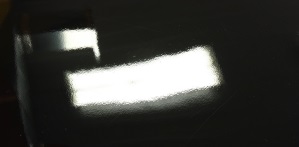For years the industry has relied on the rotary polisher, aggressive wool pads, and heavy-cut compounds for doing major paint correction work. This combination does a good job, but has a few drawbacks. First, you need to be skilled and educated on this process to get good results, and can be quite dangerous in the hands of a beginner. And secondly, this aggressive approach cuts well at the expense of the finish that you get afterwards…typically you’ll need several refining steps to clean up the marring, swirls, and haze left behind from the wool.
The Porter Cable D/A polisher has brought a new level of ease into the market, and many have stepped into the realm of paint correction detailing due to the relative ease of use and safe operation (much less of a risk of burning through an edge compared to a rotary polisher). But the one drawback (or myth) has been that you can’t get that really high level of correction in comparison to the rotary.
When Meguiar’s introduced the M105 Ultra-Cut Compound a few years ago, it completely opened the market to an entirely new level of heavy cut with a fine finish on a D/A polisher. It was (and still is) a revolutionary product…a game changer.
And when the detailing industry discovered the Surbuf pads, it took the combination of the D/A polisher and Meguiar’s M105 to even greater heights.
With this combination, you can get rotary/wool level of correction with a much finer finish and less of a risk of buffer burn. I say less because there’s still a chance…this combination cuts hard and fast, and you still need to be very careful around edges, ridges, and any other notoriously thin spots.
And why is a much finer finish (than wool/rotary) so important? Well for one thing, you’re not worrying about heavy holograms that will be leftover with the wool/rotary. Secondly, the more work of cutting and finishing that you do during the compounding stage means much less time and work that will be required on the finishing stage. Some may like to do 3, quicker polishing steps, but me…I prefer spending a little more time compounding to get as much of the work out of the way as possible, so that my finishing step is only removing a slight haze and therefore goes much more quickly.
Since this is such an aggressive combination, I only recommend it for high levels of defects (swirls, scratches, etc). You always want to use the least aggressive method necessary in the interest of paint preservation, but when you’ve got your work cut out for you, then this is a great option.
You’ve seen plenty of videos on how to use the Porter Cable, and perhaps even others showing how to use the Surbuf pad in particular. But have you ever seen somebody go so far as to tackle a freshly sanded panel with it? I’m thinking no…so that’s why I decided to throw some really heavy defects at this combination to show everybody just how powerful it really is.
I was faced with a targa top on a Ferrari F355 that had been (poorly) repainted at a body shop, and the texture / orange peel was so bad that you could spot it from across the parking lot. The only way this was going to be fixed was by heavy wetsanding.
Here’s what a closeup of the top looked like before I started:
This is what it looked like after D/A sanding first with P1500, then with P3000 grit sandpaper.
Now that the stage is set and the panel has been sanded down, let’s take a close look at the Porter Cable 7424XP / Surbuf Pad / M105 process and see how it does.
Now once it was compounded using the above method, I completed my finish polishing and the targa top now looked as it should (Note…this is after compounding AND finishing…not just compounding!).
And when you looked at the finish up close in the Brinkmann LED light, there was nothing but pure, crystal clear reflections with no sanding marks, no swirls, and no haze! Perfection…
Thanks for taking the time to review the work and the video, and please feel free to add any comments or questions below.
Best regards, Todd Cooperider